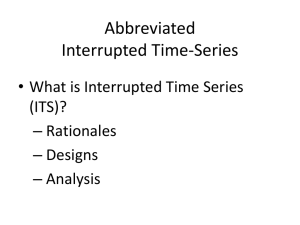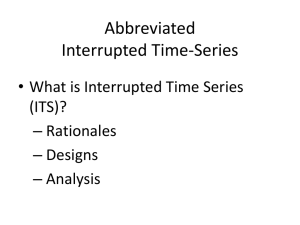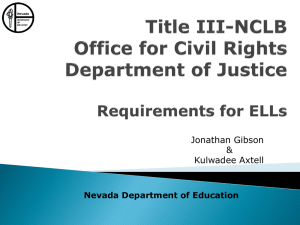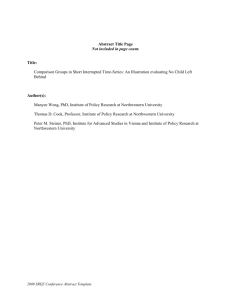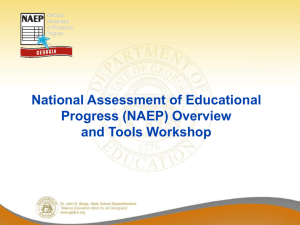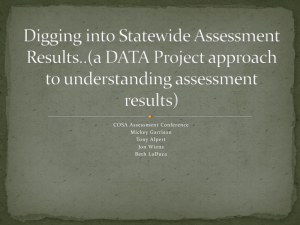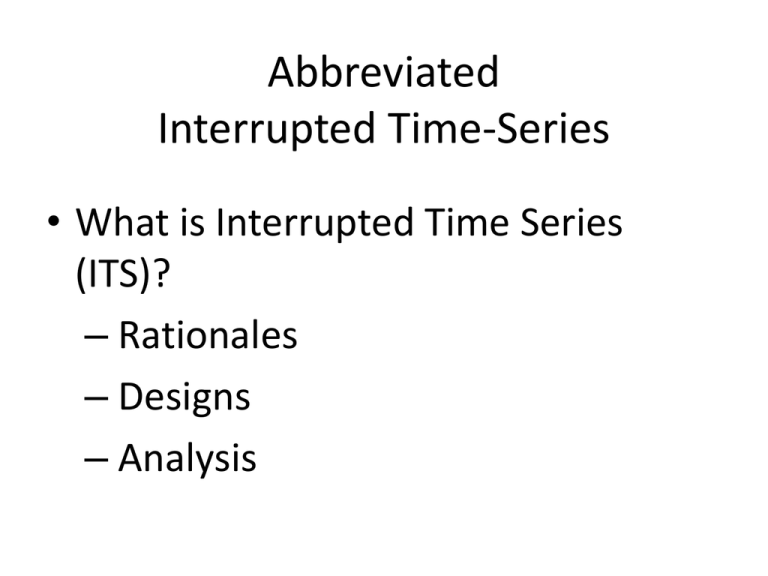
Abbreviated
Interrupted Time-Series
• What is Interrupted Time Series
(ITS)?
– Rationales
– Designs
– Analysis
What is ITS?
• A series of observations on the same dependent variable
over time
• Interrupted time series is a special type of time series
where treatment/intervention occurred at a specific
point and the series is broken up by the introduction of
the intervention.
• If the treatment has a causal impact, the postintervention series will have a different level or slope
than the pre-intervention series
The effect can be a change in
intercept
Number of Calls
The effects of charging for directory
assistance in Cincinnati
1000
900
800
700
600
500
400
300
200
100
0
1962
Intervention
1964
1966
1968
1970
Year
1972
1974
1976
The effect can be a change in
slope
Canada Sexual Assault Law Reform
3000
Rape Reform Law
Number of Assaults
2500
2000
1500
1000
500
0
1981
1982
1983
1984
1985
Year
1986
1987
1988
The effect can be delayed in
time.
The effects of an alcohol warning label on
prenatal drinking
0.8
prenatal drinking
0.6
Label
Law
Date
0.4
0.2
0
-0.2
Impact
Begins
-0.4
-0.6
86 -8 7 -87 -87 -8 8 -88 -88 -8 9 -89 -89 -9 0 -90 -90 -9 1 -91 -91
y
y
y
y
y
n
n
n
n
n
p
p
p
p
p
p
J a Ma Se
J a Ma Se
J a Ma Se
J a Ma Se
J a Ma Se
Se
Month of First Prenatal Visit
Interrupted Time Series Can Provide Strong Evidence
for Causal Effects
•
Clear
Intervention
Time Point
•
Huge and
Immediate
Effect
•
Clear Pretest
Functional
Form + many
Observations
•
No alternative
Can Explain
the Change
How well are these
Conditions met in Most Ed Research?
• The Box & Jenkins tradition require roughly 100
observations to estimate cyclical patterns and error
structure, but
• This many data points is rare in education, and so we
will have to deviate (but borrow from) the classical
tradition.
• Moreover,…
Meeting ITS Conditions in Educational
Research
• Long span of data not available and so the pretest
functional form is often unclear
• Implementing the intervention can span several
years
• Instantaneous effects are rare
• Effect sizes are usually small
• And so the need arises to develop methods for
abbreviated time series and to supplement them
with additional design features such as a control
series to help bolster the weak counterfactual
associated with a short pretest time series
Abbreviated Interrupted Time Series
• We use abbreviated ITS loosely
– series with only 6 to 50 time points
• Pretest time points are important
– valuable for estimating pre-intervention growth
(maturation)
– control for selection differences if there is a
comparison time series
• Posttest for identifying nature of the response,
especially its temporal persistence
Theoretical Rationales for more
Pretest Data Points in SITS
• OXO
• Describes starting level/value - yet fallibly so
because of unreliability
• But pre-intervention individual growth is not
assessed, and this is important in education
OOXO
• Describes initial standing more reliably
by averaging the two pretest values
• Describes pre-intervention growth better,
but even so it is still only linear growth
• Cannot describe stability of this
individual linear growth estimate
OOOXO
• Initial standing assessed even more reliably
• Individual growth model can be better
assessed—allow functional form to be more
complex, linear and quadratic
• Can assessed stability of this individual
growth model (i.e., variation around linear
slope)
Generalizing to 00000000X0
• Stable assessment of initial mean and slope
and cyclical patterns
• Estimation of reliability of mean and slope
• Help determine a within-person
counterfactual
• Check whether anything unusual is
happening before intervention
Threats to Validity: History
• With most simple ITS, the major threat to
internal validity is history—that some other
event occurred around the same time as the
intervention and could have produced the
same effect.
• Possible solutions:
– Add a control group time series
– Add a nonequivalent dependent variable
– The narrower the intervals measured (e.g.,
monthly rather than yearly), the fewer the
historical events that can explain the findings
within that interval.
Threats to Validity: Instrumentation
• Instrumentation: the way the outcome was
measured changed at the same time that the
intervention was introduced.
– In Chicago, when Orlando Wilson took over the
Chicago Policy Department, he changed the
reporting requirements, making reporting more
accurate. The result appeared to be an increase in
crime when he took office.
– It is important to explore the quality of the
outcome measure over time, to ask about any
changes that have been made to how
measurement is operationalized.
Threat to SCV
• When a treatment is implemented slowly and
diffusely, as in the alcohol warning label study, the
researcher has to specify a time point at which the
intervention “took effect”
– Is it the date the law took effect?
– Is it a later date (and if so, did the researcher
capitalize on chance in selecting that date)?
– Is it possible to create a “diffusion model” instead
of a single date of implementation?
Construct Validity
• Reactivity threats (due to knowledge of being
studied) are often less relevant if archival data
are being used.
• However, the limited availability of a variety of
archival outcome measures means the
researcher is often limited to studying just one
or two outcomes that may not capture the
real outcomes of interest very well
External Validity
• The essence of external validity is exploring
whether the effect holds over different units,
settings, outcome measures, etc.
• In ITS, this is only possible if the time series
can be disaggregated by such moderators,
which is often not the case.
Adding a Control Group Time
Series
OXO
O O
• Now we add a comparison group that did not
receive treatment and we can
• Assess how the two groups differ at one
pretest
• But only within limits of reliability of test
• Have no idea how groups are changing over
time
O OXO
O O O
• Now can test mean difference more stably
• Now can test differences in linear growth/change
• But do not know reliability of each unit’s change
• Or of differences in growth patterns more
complex than linear
O O OXO
O O O O
• Now mean differences more stable
• Now can examine more than differences in linear
growth
• Now can assess variation in linear change for
each unit and for group
• Now can see if final pre-intervention point is an
anomaly relative to earlier two
Example from Education: Project Hope
• A merit-based financial aid program in Georgia
– Implemented in 1993
– Cutoff of a 3.0 GPA in high school (RDD?)
• Aimed to improve
– Access to higher education
– Educational outcomes
• Control Groups
– US data
– Southeast data
Results:
Percent of Students Obtaining High School GPA 3.00
Percent of Students Reporting B or Better
90.00%
Percent
88.00%
86.00%
84.00%
82.00%
Southeast
80.00%
78.00%
GA
US
76.00%
74.00%
Year
Results:
Average SAT scores for students reporting high school GPA 3.00
Avg SAT Scores, Students Reporting B or Better
1,060
1,020
Southeast
1,000
US
980
GA
960
Year
20
00
98
96
94
92
940
90
SAT Scores
1,040
Adding a nonequivalent dependent
variable to the time series
NEDV: A dependent variable that is predicted not
to change because of treatment, but is expected
to respond to some or all of the contextually
important internal validity threats in the same
way as the target outcome
Example: British Breathalyzer Experiment
• Intervention: A crackdown on drunk driving using a breathalyzer.
• Presumed that much drunk driving occurred after drinking at pubs
during the hours pubs were open.
• Dependent Variable: Traffic casualties during the hours pubs were
open.
• Nonequivalent Dependent Variable: Traffic casualties during the hours
pubs were closed.
• Helps to reduce the plausibility of history threats that the decrease
was due to such things as:
– Weather changes
– Safer cars
– Police crackdown on speeding
Note that the outcome variable (open hours on weekend) did show an
effect, but the nonequivalent dependent variable (hours when clubs
were closed) did not show an effect.
Example: Media Campaign to Reduce Alcohol Use
During a Student Festival at a University (McKillip)
• Dependent Variable: Awareness of alcohol abuse.
• Nonequivalent Dependent Variables (McKillip calls
them “control constructs”):
– Awareness of good nutrition
– Awareness of stress reduction
• If the effect were due to secular trends (maturation)
toward better health attitudes in general, then the
NEDVs would also show the effect.
Only the targeted dependent variable, awareness of responsible
alcohol use, responded to the treatment, suggesting the effect is
unlikely to be due to secular trends in improved health awareness
in general
3.2
Awareness
3
Good Nutrition
Campaign
Stress Reduction
Responsible Alcohol Use
2.8
2.6
2.4
2.2
2
28-Mar 30-Mar 4-Apr
6-Apr 11-Apr 13-Apr 18-Apr 20-Apr 25-Apr 27-Apr
Date of Observation
Adding more than one nonequivalent
dependent variable to the design of SITS
to increase internal validity
Example: Evaluating No Child Left Behind
NCLB
• National program that applies to all public
school students and so no equivalent group
for comparison
• We can use SITS to examine change in
student test score before and after NCLB
• Increase internal validity of causal effect by
using 3 possible types of non-equivalent
groups or 3 types of contrasts for comparison
Contrast Type 1 & 2
• Contrast 1: Test for NCLB effect nationally
– Compare student achievement in public schools with
private schools (both Catholic and non-Catholic)
• Contrast 2: Test for NCLB effects at the state level
– Compare states varying in proficiency standards.
• States with higher proficiency standards are likely
to have more schools fail to make AYP and so more
schools will need to “reform” to boost student
achievement
Contrast 1: Public vs Private Schools
• Public schools got NCLB but private ones
essentially did not
–If NCLB is raising achievement in
general, then public schools should do
better than private ones after 2002
• Hypothesis is that changes in mean,
slope or both after 2002 will favor public
schools
NAEP Test Score
Hypothetical NCLB effects on public (red) versus
private schools (blue)
208
200
NCLB
Time
Contrast 1: Public vs Private Schools
• Two independent datasets: Main and Trend
NAEP data can be used to test this
• Main NAEP four posttest points. Data
available for both Catholic and other private
schools
• Trend NAEP only one usable post-2002
point and then only for Catholic schools
Analytic Model
• NCLB Public vs. Catholic school contrast
• Model
Ytj 0 1 ( year)tj 2 ( group) j 3 ( policy)tj 4 ( year group)tj 5 ( policy year)tj
6 ( policy group)tj 7 ( policy year group)tj tj ,
• Low Power
• Only 3 groups (public, Catholic, non-Catholic private) with 8 time
points. So only 24 degrees of freedom
• Autocorrelation
– Few solutions
– Cannot use clustering algorithm because there are not enough groups
– Robust s.e. used but results less conservative
Main NAEP Time Series Graphs
Public vs. Catholic
Public vs. Other Private
Main NAEP 4th grade math scores by year:
Public and Catholic schools
Main NAEP 4th grade math scores by year:
Public and Other Private schools
Difference in differences in Total change for 4th Grade Math
Analyses based on Main NAEP data
Diff in Total ∆ (2009)
4th Grade Math (All Data)
Coef. S.E.
t
Public vs. Catholic
Public vs. Other Private
+ p<0.10, * p<0.05
10.96
6.46
5.22
8.39
1.77+
0.77
4th Grade Math (Exclude 1990)
Coef.
S.E.
t
10.73
13.90
3.43
9.72
3.13*
1.43
Main NAEP 8th grade math scores by year:
Public and Catholic schools
Main NAEP 8th grade math scores by year:
Public and Other Private schools
Difference in differences in Total change for 8th Grade Math
Analyses based on Main NAEP data
Diff in Total ∆ (2009)
8th Grade Math (All Data)
Coef. S.E.
t
Public vs. Catholic
Public vs. Other Private
+ p<0.10, * p<0.05
2.91
11.16
6.64
7.95
0.44
1.40
8th Grade Math (Exclude 1990)
Coef.
S.E.
t
0.26
5.57
5.57
1.39
0.05
4.00*
Trend NAEP Time Series Graphs
Public vs. Catholic School Contrast
(Other private school data unavailable and
only 1 post-intervention time point)
Trend NAEP 4th grade math scores by year:
Public and Catholic schools
Trend NAEP 8th grade math scores by year:
Public and Catholic schools
Difference in Differences in Mean Change in 2004 for Math
Analyses based on Trend NAEP data
Public vs. Catholic Contrast
4th Grade Math
Coef.
S.E.
t
8th Grade Math
Coef.
S.E.
t
10.93
7.26
* p<0.05
5.53
1.97*
2.03
3.58*
Public vs Private School Findings
• All effects on 4th and 8th grade math are in
right direction, and some statistically
significant
• No effect on 4th grade reading but all are in
the right direction (results not shown here)
• This suggests that NCLB has a significant math
effect nationally, but…
Concerns with Contrast 1
• Possible low power due to low number of groups (3:
public, Catholic, non-Catholic private) with 8 time
points
– So only 24 degrees of freedom
• Catholic sex abuse scandals in 2002 result in parents
taking their children out of Catholic schools
• No evidence that
– school leavers caused a drop in average student
achievement in Catholic schools or
– public and other private school effects are due to
transfers from Catholic schools
• Data from other private schools provides a
unconfounded replicate, but never stat sig.
Contrast 2: Comparing States that vary
in Proficiency Standards
• Some states set high standards for making AYP and
so many schools fail and have to change their
educational practices
– (more serious NCLB implementers, higher dosage
of treatment)
• Other states set low standards and so do not have to
change much
– (less serious NCLB implementers, lower dosage of
treatment)
Define Proficiency Standards Based on the
Percentage of Students Deemed Proficient
• To determine a state’s overall level of proficiency
standard, we average the percentage of students
deemed proficient across grades (4th and 8th grade)
and across subjects (math and reading) using state
assessment data from 2003
• States that deemed less than 50% of students
proficient have high proficiency standards
• States that deemed 75% or more proficient are
states have low proficiency standards
• States between 50% and 75% are moderate
Evidence of Differing Standards
High Proficiency Standard States
State
State Test NAEP Test
Arizona
46
24
Arkansas
46
25
California
36
22
District of Columbia
48
8
Hawaii
31
21
Kentucky
47
27
Maine
35
34
Massachusetts
50
41
Missouri
29
32
Rhode Island
45
28
South Carolina
26
27
Washington
46
34
Wyoming
39
35
Mean
40
27
Low Proficiency Standard States
State
Colorado
Connecticut
Georgia
Minnesota
Nebraska
New Hampshire
North Carolina
Tennessee
Texas
Virginia
Wisconsin
State Test
83
76
76
75
80
76
85
80
84
75
77
NAEP Test
35
39
25
40
33
39
34
24
28
35
35
79
33
1
Results are averaged across grades (4th and 8th grade), subjects (math and reading) in year 2003
for state and NAEP assessment.
Note: When state assessment data are missing in the grade examined, data from the next lower
grade are used and if not available then data are from the next higher grade.
Source: Consolidated State Performance Report and Institute of Education Science
So Contrast 2 is…
• Compare states at three levels of standards high, medium and low
– Cut offs at 50% and 75% of students being
proficient
• Hypothesis is that in states with higher
standards there should be more of a post2002 change in mean, slope or both
• Using Main NAEP data from 1990 to 2009 for
Math and to 2007 for 4th grade Reading
Main NAEP Time Series Graphs
States with High vs. Medium vs. Low
Proficiency Standards
Adjusting for Autocorrelation
• NCLB State Contrast
• Option 1:
– HLM model can control for autocorrelation
Level 1:
Yti 0i 1i ( year) ti 2i ( policy) ti 3i ( year policy) ti ti
Level 2:
0i 00 01 ( group)i 02 ( percent_ free _ lunch)
03 ( pupil_ teacher_ ratio) 0i
1i 10 11 ( group) i 1i
2i 20 21 ( group) i 2i
3i 30 31 ( group)i 3i
Analytic Model – Cont.
• Full Model
Yti 0 1 ( year) ti 2 ( policy) ti 3 ( policy year) ti 4 ( group_ h ) i 5 ( group_ m) i
6 ( year group_ h ) ti 7 ( year group_ m) ti 8 ( policy group_ h ) ti 9 ( policy group_ m) ti
10 ( policy year group_ h ) ti 11 ( policy year group_ m) ti
12 ( percent_ free _ lunch) i 13 ( pupil_ teacher_ ratio) i
[ 0i 1i ( year) ti 2i ( policy) ti 3i ( policy year) ti ti ] ,
• Main Variables of Interest
8 ( policy group _ h)
10 ( policy year group _ h)ti
Adjusting for Autocorrelation
• Option 2:
• Fixed effects model because we are looking at
the entire population of states
– Use cluster option in stata
Yti 0 1 ( policy) ti 2 ( policy year) ti 3 ( year group_ h) ti 4 ( year group_ m) ti
5 ( policy group_ h) ti 6 ( policy group_ m) ti
7 ( policy year group_ h) ti 8 ( policy year group_ m) ti
9 ( percent _ free _ lunch) ti 10 ( pupil _ teacher_ ratio) ti i t ti ,
Main NAEP 4th grade math scores
by year and proficiency standards
Main NAEP 8th grade math scores
by year and proficiency standards
Difference in differences in 2009 Total change for Math
Analyses based on Main NAEP data
High vs. Low Proficiency Standards
Diff in Total ∆ (2009)
+p<0.1, *p<0.05
4th Grade Math
Coef. S.E.
t
8th Grade Math
Coef. S.E.
t
7.38
6.97
3.33
2.22*
3.38
2.06*
Contrast 2 Study Conclusions
• NCLB increased
– 4th Grade Math
– 8 points.
– 6 months of learning
– .26 SD
– .21 Pct
– 8th grade math
– 8 points
– 12 months of learning
– .19 SD
– .20 pct
– 4th Grade Reading
• No significant effect for either contrast but all are
in the hypothesized direction
Overall Conclusions
• Similar results obtain from both strategies:
– significant 4th and 8th grade math effects but not for
reading
• Viable internal threats are factors independent of NCLB
that changed in 2002 and are correlated with both the
public/private and the high/low proficiency contrasts
• Most alternative interpretations do not apply to both
strategies, and this should reduce concerns about
internal validity
• A few are shared (e.g., changes in math standards in
public schools in 2002). These are discussed in the paper
and shown to highly unlikely.
Contrast 3:
Dee & Jacob
Basic Insight of D & J
• NCLB passed in 2002 and is a system of accountability by
performance standards with inevitable sanctions for
school failure
• Some states had such a system earlier - e.g, via Improving
American Schools Act
• States whose accountability system pre 2002 had no
sanctions then become “treatment” group that gets
consequential accountability (CA) via NCLB in 2002
• States with systems that had sanctions pre-2002 then
become a comparison group post 2002
Basic Method of D & J
• Prior studies can be used to determine which
states did and did not have accountability system
pre 2002
• Dee & Jacob uses Hanushek’s measure
• Main NAEP provides the pre-intervention (2002)
and post-intervention time-series for both
reading and math
• Hypothesis again is that NCLB should increase
mean or slope or both after 2002 by more in
states without a prior accountability system
D & J Results: 4th Grade Math
D & J Results: 8th Grade Math
Dee and Jacob Results
• Similar causal findings to Wong, Cook
& Steiner
• Strong Evidence of a 4th Grade Math
Effect
• Some evidence of 8th Grade Math
Effect
• No Reading Effect
Two Causal Mechanisms
• D & J claim results due to NCLB requiring some states to insert
sanctions into their accountability systems in 2002 - the
consequential accountability mechanism (CA)
• WC&S claim their results due to higher proficiency standards
after 2002 imposing more sanctions and school change
compared to states with lower proficiency standards - the
proficiency standards mechanism (S)
• Correlation between two - our measure and Hanushek’s - is
.05. So independent mechanisms.
• How do the two combined relate to reading?
4th Grade Reading
Differences in differences in total change post-NCLB
4th Grade Reading
Coef.
S.E.
t
Wong et. al. vs. Dee and Jacob
Diff in Total ∆ by 2009 (S+CA)
Diff in Total ∆ by 2009 (S)
Diff in Total ∆ by 2009 (CA)
5.60
1.34
1.98
2.50
2.67
2.56
2.24
0.50
0.78
*
Wong (median) vs. Dee and Jacob (all)
Diff in Total ∆ by 2009 (S+CA)
Diff in Total ∆ by 2009 (S)
Diff in Total ∆ by 2009 (CA)
Interaction Effect
4.19
1.96
2.05
0.18
1.68
1.80
1.66
2.18
2.49
1.09
1.24
0.08
*
+p<0.1, *p<0.05
The Use of Multiple Comparison Groups
and Replications
• ALL three ITS contrasts point to a clear math effect
– public vs. private
– high vs. low standards
– early versus late CA
• When Standards and CA are combined, a modest reading
effect appears in states that have a new sanction system and
set high standards compared to states that already have a
sanction system in place but set low standards after 2002.
Why did we need multiple
comparison TS?
Adding Treatment Introduction
and Removal: Examples from
Research on Students with
Disabilities
Example: Ayllon et al., A Behavioral Alternative
to Drugs for Hyperactive Students
• Drugs control hyperactivity, but can interfere
with academic performance
• Ayllon et al. used a behavioral intervention to
try to control hyperactivity while improving
academic performance as measured by
– Math
– Reading
Medication
decreased
hyperactivity, but
also affected
academic
performance.
Removal of
medication
increased
hyperactivity
but allowed
academic
performance to
recover a bit.
The behavioral
reinforcement
program reduced
hyperactivity but
allowed academic
performance to
increase even more.
Multiple Baselines on Different
Dependent Variables
Example: Chorpita
• A child with difficulties attending school, with
symptoms including
– Somatic complaints
– Tantrums and anger
– Crying
• Intervention was a behavioral extinction and
reinforcement schedule
• Multiple baseline adding treatment for each of
the three symptoms over time.
Initially, only somatic
complaints were targeted.
Then, both somatic
complaints and
anger/tantrums were
targeted.
Finally, all three sets of
symptoms were targeted
in the third phase.
Multiple Baselines on Different Units
Example: Blandford and Lloyd
• Two learning disabled boys
• Intervention: A self-instructional card with seven
instructions on how to improve handwriting.
• Outcome: Percent of possible points on a
handwriting test
• Multiple Baseline: Intervention was introduced at
two different times for the two boys.
7
6
5
4
PKU Retardation
Admissions
PKU Retardation
Admissions
The effects of screening for
phenylketonuria retardation
3
2
1
0
47- 50- 53- 56- 59 60
49 52 55 58
61 62 63 64 65
3.5
3
2.5
2
1.5
1
0.5
0
66 67 68 69 70 71
47- 50- 53- 56- 59 60 61 62 63 64 65 66 67 68 69 70 71
49 52 55 58
PKU Screening Adopted in 1962
PKU Screening Adopted in 1963
PKU Retardation
Admissions
PKU Retardation
Admissions
6
5
4
3
2
1
0
47- 50- 53- 56- 59 60 61 62 63 64 65 66 67 68 69 70 71
49 52 55 58
PKU Screening Adopted in 1964
7
6
5
4
3
2
1
0
47- 50- 53- 56- 59 60 61 62 63 64 65 66 67 68 69 70 71
49 52 55 58
PKU Screening Adopted in 1965
Analyses for Short Time Series
• Early proposals to use ordinary least squares
statistics
• The above ignores the fact that times series
data are auto-correlated
Multilevel Models: Current Work
Applying multilevel models to these data allows for
different behavior patterns across cases, and can
account for those differences using characteristics of
the cases in the model.
We began analyses with a 1-phase study (treatment
only), then 2-phase studies (AB), and are now
working to model 4-phase studies (ABAB).
At each stage, we’ve discovered new technical issues
to be considered and accommodated.
90
Potential advantages of using HLM to analyze and
synthesize SCD data both within and across studies:
1.
Appropriately considers observations as nested within
cases
2.
Does not require that all cases have the same number of
observations or the same spacing of observations over
time
3.
Allows treatment effects to vary across cases, attempting
to explain any heterogeneity of effects by adding subject
or setting characteristics to the model
4.
Can provide reliable estimates even with only few data
points per cases
91
Potential drawbacks of using HLM to analyze
and synthesize SCD data (both within and
across studies):
1.
Can be intimidating to some researchers
2.
Can be difficult to estimate parameters when models
get complex
Especially when number of time points and
number of cases is small.
Especially when modeling quadratic terms.
Especially when using a fully random effects
model.
92
Example: Stuart 1967
• 8 time series, one on each of 8 people
• Weight loss intervention over one year
• Wt loss in pounds as dv
• Here are the 8 time series:
Stuart Data
Example (Stuart, 1967)
94
Level 1 (time within persons)
95
Level 2 data: Persons
Level-2 data (subject characteristics):
96
An Example of Modeling These Data in
HLM
Building a Simple Linear Model in HLM:
POUNDSij = π0 + π1*(MONTHS12) + eij
π0 = average ending weight
π1 = average rate of change in weight per month
97
HLM: Linear Model Estimates
Final estimation of fixed effects:
Standard
Coefficient Error
Approx.
T-ratio
Fixed Effect
d.f. Pvalue
---------------------------------------------------------For INTRCPT1,P0
INTRCPT2, B00 156.439560 5.053645 30.956
7
0.000
For
MONTHS12 slope, P1
INTRCPT2, B10
-3.078984 0.233772 13.171
7
0.000
---------------------------------------------------------The outcome variable is POUNDS
----------------------------------------------------------
POUNDSij ≈ 156.4 – 3.1*(MONTHS12) + eij
98
Quadratic Model Building
POUNDSij = π0+ π1*(MONTHS12)+ π2*(MON12SQ)+eij
π0 = average ending weight
π1 = average rate of change in weight per month near the end of
the study
π2 = average rate of change in slope, or effect of time on weight
loss
99
HLM Output from Quadratic Model:
Final estimation of fixed effects:
Standard Approx.
Fixed Effect
Coefficient Error
T-ratio d.f. P-value
----------------------------------------------------------For INTRCPT1, P0
INTRCPT2, B00 158.833791 5.321806 29.846
7
0.000
For MONTHS12 slope, P1
INTRCPT2, B10 -1.773039
0.358651
-4.944
7
0.001
For MON12SQ slope, P2
INTRCPT2, B20
0.108829 0.021467
5.070
7
0.001
----------------------------------------------------------The outcome variable is
POUNDS
-----------------------------------------------------------
POUNDSij ≈ 158.8 – 1.8(MONTHS12) + 0.1*(MON12SQ) + eij
10
0
Comparing Models
Stuart (1967) – Actual Data
Linear Model Prediction (HLM)
215.7
226.2
196.2
POUNDS
POUNDS
203.3
180.5
176.7
157.2
157.7
137.8
-12.00
134.8
-12.60
-9.00
-6.00
-3.00
0
MONTHS12
-9.30
-6.00
-2.70
0.60
MONTHS12
Quadratic Model Prediction (HLM)
Even graphically, the quadratic
model looks to be a better fit to the
original data.
Patients lost weight at a faster rate
at the beginning of treatment and
at a slower rate towards the end of
the one-year treatment.
219.2
POUNDS
199.1
179.0
158.8
138.7
-12.00
-9.00
-6.00
MONTHS12
-3.00
0
So Simple: What Could Go Wrong?
HLM has problems
when all effects are random
with autoregressive model
WinBUGS works well, but harder to learn
Fortunately, the WinBUGS estimates closely
approximate the HLM estimates.
10
2
What Else Could Go Wrong?
• Different studies have time series that use
different outcome metrics (both between and
often within studies)
– Counts, rates, means, ratings, totals, etc.
– With timed or untimed administration
– With constant or variable number of “items”
Problematically
• Different combinations of these have different
distributions, e.g.,
– Binomial for counts with fixed n of trials
– Poisson for rates with variable n of trials
• HLM usually assumes normally distributed data.
– One can change this, but
– It isn’t clear HLM how can allow different distributions for
different studies in the same meta-analysis.
So We Are Working On
• Categorizing the different kinds of metrics and
associated distributions, and
• Seeing whether they can be modeled correctly
in programs like HLM or WINBUGS.
Do you have any examples to share with us?
Summary
• ITS is a very powerful design, but feasibility depends
on the availability of a good archived outcome, or
ability to gather original data
• Much prior information is available in education, at
individual, cohort and school levels
• But it is not much used in education outside of
special education with individual cases. Why?
Its use is not recommended without a comparison
time series due to unclear extrapolations from
pretest alone and uncertainty about when an effect
should appear

